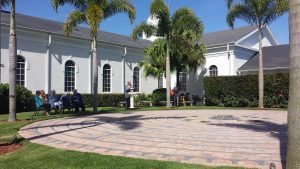
In all of my many years of visiting faith communities I’ve yet to encounter one that proudly proclaimed its church campus was designed for use for an hour or two on Sunday morning and designed to go unused the rest of the week. I have, however, encountered plenty of churches that use their sanctuaries and other worship spaces only a few hours a week and/or have entire wings or buildings that are unused or used less frequently than once a week.
For Members Only
For some declining congregations the sanctuary (and in extreme cases the entire church campus) is for members only. Spaces with this designation are not allowed to be used by outside groups. Often a disproportionate part of the buildings and grounds budget (and sometimes the overall annual operating budget) is used to care for these spaces. And when in use by the church the spaces are often nowhere near full.
At best, such efforts are focused on maintenance. For some congregations that have experienced numeric loss decade after decade for quite some time there can become a fixation on ensuring that this part of congregational life continues even if everything else is falling down around it.
At worst, this unhealthy inwardly focused behavior is an accelerant that inevitably spreads throughout the life of the faith community all but ensuring a future that ends with death as the doors close one final time.
For Everyone, Always
Donna Schaper, Senior Minister at the future oriented Judson Memorial Church in New York City, recently shared some of the story of her congregation’s journey from the 1960s to present focused on opening their spaces to increasing numbers who are not members (or even active participants) in the life of their faith community. In this congregation’s case removal of church pews opened their largest sacred space for increased usage. This change of furniture happened nearly 40 years ago but continues to be a blessing as the congregation welcomes more and more people to its campus each week for its own activities as well as those led by other groups. Judson Memorial is intentional about using its space for everyone, always. In their case this looks like giving half of it away and generating revenue on the other half. Currently, the congregation’s rental income exceeds $300,000 a year.
So What?
There is no one size fits all process for maximizing the space your congregation owns or leases. There is, however, much that can be done to ensure that every space resource your faith community has entrusted to it is intended for use by everyone, always (or at least as many hours of the day as each building can be made open for use).
Think of your church campus utilization on a continuum with one extreme being that all use is for members only and the other is that it is always open to everyone.
- If your congregation falls anywhere near the middle or toward the end of members only, then this may be an excellent time to evaluate how this has happened and what is needed to create change.
- If your congregation falls somewhat toward the end of always being open and intentionally looking for ways to invite use of your campus by groups with no affiliation, then this may be an excellent time to evaluate your current level of success and to establish (or refine if already established) measurable goals for increased utilization in the years to come.
Your church campus is the part of your faith community that everyone sees. Good stewardship of all such space is essential.
- Is your congregation’s use of its campus consistent with its overall mission and vision?
- Are you familiar with the strategy your congregation has for use of all of the spaces that make up your church campus?
- What percentage of all available space of each type (ex: worship, education, recreation, etc.) does your congregation use? Is the remainder available to the community for rent (or is some space reserved for the congregation’s exclusive use even if such is limited to a few hours a week? Is rental income or space utilization more important?